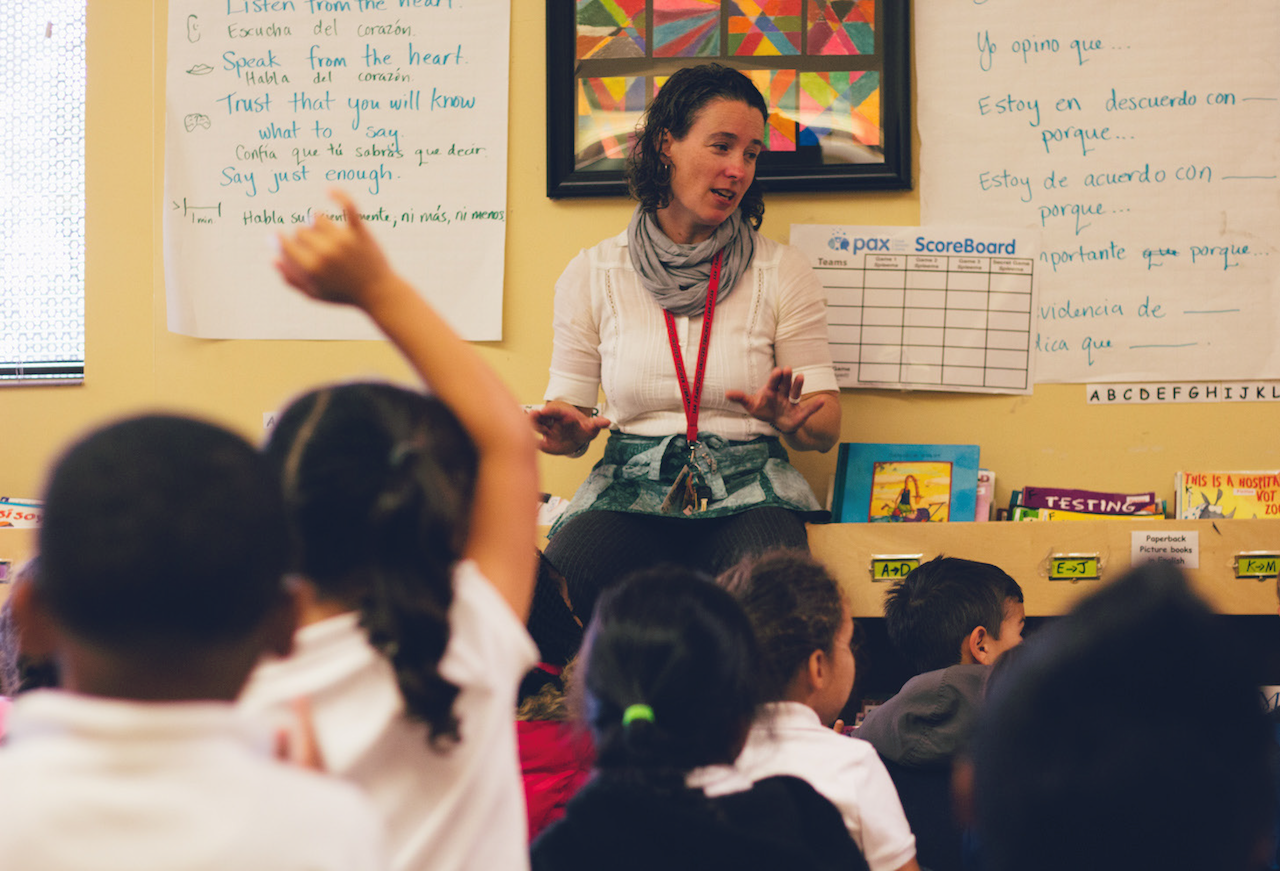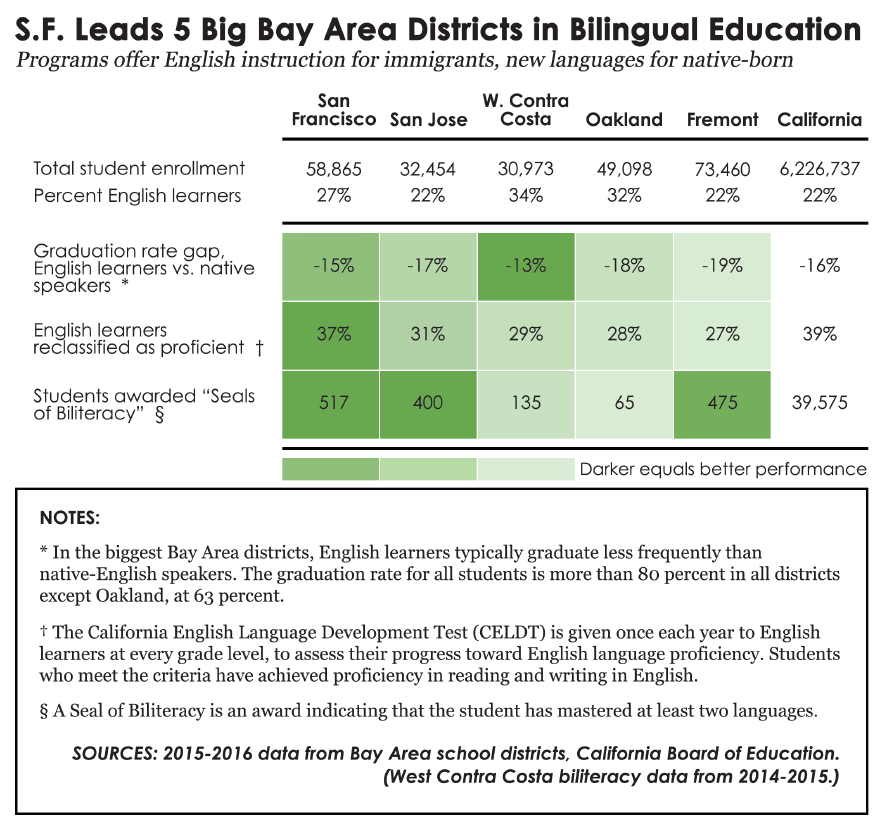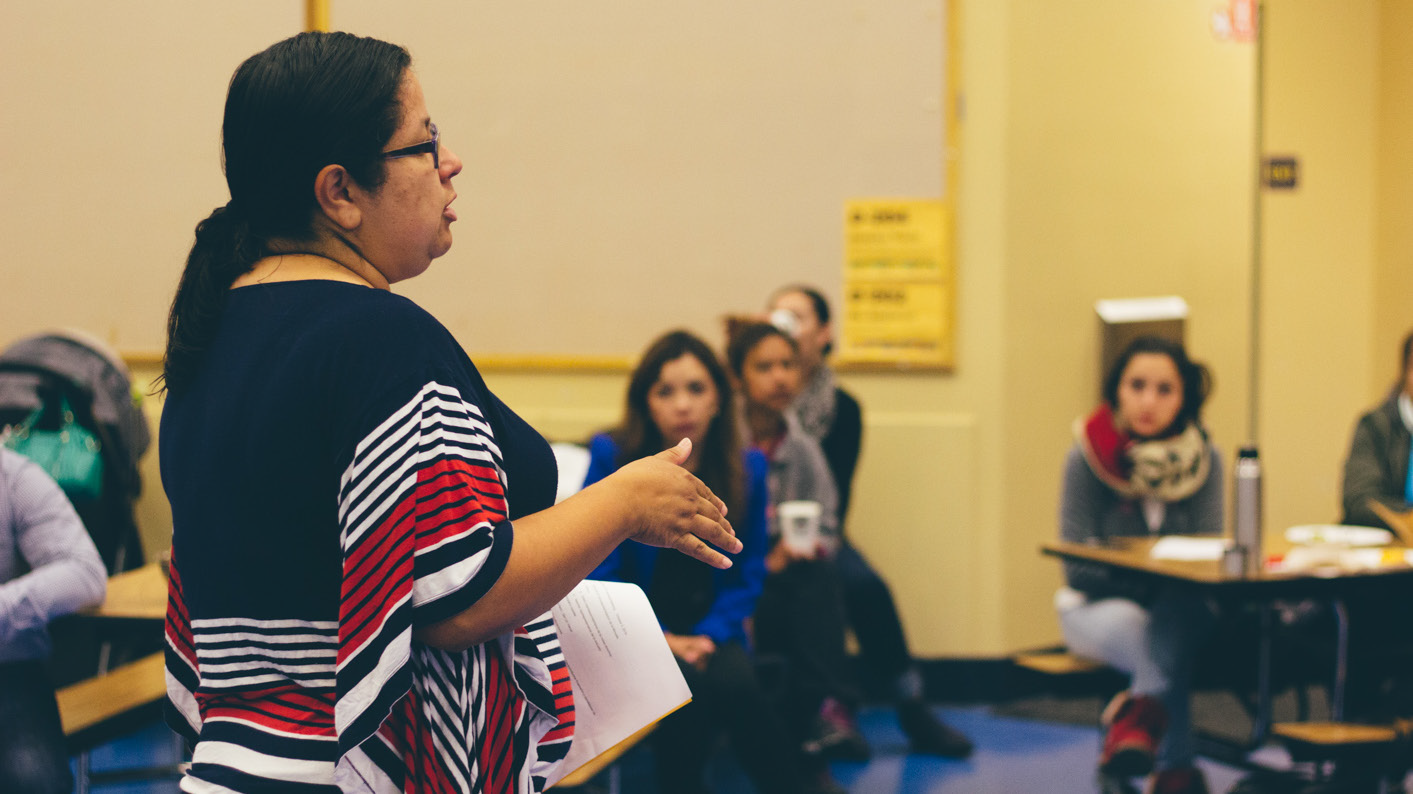In 1998, California Proposition 227 tore the state apart. Requiring English-only instruction to discourage schools from teaching immigrant students in their home languages, the measure passed by a wide margin.
Fast-forward to 2016. Donald Trump won the presidency, with a promise to build a wall between Mexico and the United States. But just as the country seemed to turn against its immigrants, California went in a different direction. On Nov. 8, nearly three-quarters of voters neutralized Proposition 227 with a new measure, Proposition 58, called the “California Education for a Global Economy Initiative.”
Proposition 58 not only encourages immigrants to retain their home languages while learning English. It also opens to the door to teaching more U.S.-born children other languages, often through dual-language immersion programs that put them in classrooms with immigrants.
The timing of Proposition 58 could not be better for the San Francisco Unified School District. Demand for language education is rising, but not because of increased immigration — in fact, the number of English-learners is slightly lower than it was when Proposition 227 passed. It is because so many parents want their U.S.-born children to learn another language.
For almost two decades, San Francisco Unified largely ignored Proposition 227. It changed the names of its programs and expanded, instead of limited, its language offerings, especially the dual-language immersion programs. Today in San Francisco, thousands of students are learning English alongside Spanish, Mandarin, Cantonese or Korean.
“We have kids entering education systems with enormous assets. But rather than cherish that asset, and strengthen it, and promote it, our schools devalue it, shame students for it, and take it away from them.”— Ilana Umansky, University of Oregon
The result? According to academic studies and California Department of Education data, English-learners are likely to be reclassified as proficient more in San Francisco than in districts of similar size and composition. Over time, their academic achievement tends to be greater than that of immigrants in other kinds of programs, including those pushed into English immersion. San Francisco Unified also seems to succeed in producing more multilingual students, both immigrant and native-born.
But there is a catch: The rest of the state may not be ready for the shift toward more bilingual education. For 18 years, the state has actively discouraged language education at its schools. This means that even as demand for bilingualism is growing, the state lacks teachers, standards, curricula and reading materials.
“It’s potentially a real win-win for our kids, for our economy,” said Patricia Gándara, co-director of the Civil Rights Project at UCLA. “But legislators need to get behind public policy that would support this shift.”
THE RISE OF DUAL-LANGUAGE IMMERSION
Christina Wong was an organizer in San Francisco’s Chinese community the year Proposition 227 passed. “At that time, it was like, oh, wow, yet another anti-immigrant initiative,” she recalled. “We were really fearful that the rhetoric out there was so anti-immigrant.”
Ron Unz, the Silicon Valley entrepreneur and Republican activist who bankrolled Proposition 227, said that his measure was never intended to be anti-immigrant — and that he adamantly opposed Proposition 58.
“My views haven’t changed at all,” he said before the election. Programs that provide instruction to immigrants in their first languages discourage English acquisition and cultural assimilation, he argued, and that as a result of efforts like his, “bilingual programs largely disappeared throughout the United States.”
Programs labeled “bilingual” may have declined, but dual-language immersion and other pathways to bilingualism are flourishing. In 2000, there were around 260 programs in the United States. This put English-learners in classrooms with native English-speakers to learn two languages. While no one knows quite how many there are today, 39 states (and Washington, D.C.), offer dual-language programs. Recent estimates put the number of programs at more than 2,000.
California has 312 of those schools. Twenty-seven are in San Francisco, which also has a similar number of schools that offer “biliteracy pathways” targeted at only English-learners.
Today, Wong oversees language pathways for San Francisco Unified. When Proposition 227 passed, many districts in California stopped offering dual-language immersion and support to English-learners, according to Wong and other educators.
That was not the case in San Francisco. The district grappled with the new law by changing the names of its programs — from “bilingual” to “biliterate” or “dual-language immersion” — and requiring parents to sign waivers for children to enter them. The waivers were a provision of Proposition 227 that Unz explicitly described as a bureaucratic hurdle to discourage parents from sending their children to multilingual programs.
Waivers added significantly to staff workload and the district’s bureaucracy, Wong said. Of the 15,000 students learning English in any given year, about 10,000 needed waivers. This was often the result of intensive one-to-one outreach to immigrant parents, who needed to hear their options in a system that is notoriously difficult for all parents to navigate.
The most immediate effect of Proposition 58 is to eliminate the layer of bureaucracy created by the waiver system that Proposition 227 created, said Wong.
But it will do something else, she suggested: open the door to more support from the state for multilingual education as well as collaboration with other districts in establishing statewide standards and sharing best practices. Seven states, including Utah, Washington and New Mexico, have specific policies to support dual-language education.
Because of Proposition 227, California lacks such policies. With the passage of Proposition 58, that stands to change. After almost two decades, districts like San Francisco Unified will get help in meeting demand for language education — if the state is willing and able to provide support.
PARENTS PUSH FOR DUAL-LANGUAGE IMMERSION
Like many university-educated San Francisco parents, Alex Wise and Moira deNike have treated parenthood like a research project.
“We looked at the data that showed some real benefits to having a bilingual education at a young age,” Wise said. One 2012 study, for example, found that bilinguals are better at solving both word and math problems.
He and deNike also had a personal motivation: Both are multilingual, and she was one of the first students in the 1970s to be part of the Japanese Bilingual Bicultural Program, which today makes its home at Rosa Parks and Clarendon schools in San Francisco. Like Wise, she wanted her own daughter to learn another language — and she argued for Spanish. Today, their daughter is a fourth-grader at Fairmount Elementary, a dual-language immersion school in Glen Park.
Given the state’s demographics, she said, “being able to speak Spanish in California is part of helping to ensure a more seamless California, to have more cultural competency in a state that is increasingly Spanish-speaking.”
To Unz, that is the problem. In a series of essays published since Proposition 227 passed, Unz laid out a subtle case against a multilingual, multicultural California. In a 1999 essay for Commentary titled “California and the End of White America,” Unz wrote that the state’s future depended on its ability to assimilate immigrants into the dominant white, English-speaking culture. To not do so, he wrote, risked an identity-based backlash from whites. Seeming to anticipate Trump’s successful campaign for president, he concluded, “There are few forces that could so easily break America as the coming of white nationalism.”
The campaign for Proposition 227 was careful to enlist Latino supporters dissatisfied with the state of bilingual education. Today, Unz, who ran unsuccessfully for U.S. Senate as a Republican in the June primary, continues to argue that it is immigrants who are hurt the most when schools try to preserve their native language and culture.
“The problem with these programs is that they don’t really help the Latino students learn English,” he said.
Unz is critical of how most programs — as is the case at Fairmount — start with the immigrant language and then gradually introduce English. This, he said, is actually to the benefit of the native-born.
“Anglo parents want more dual-immersion programs, but I think what is probably happening is that they want a copious supply of unpaid Spanish-language tutors to help their children learn Spanish,” Unz said, equating Latino children with “unpaid tutors.”
Diana Vasquez does not see it that way. She left Mexico in 2005, hoping that her children would have more educational opportunities. At Fairmount Elementary, her two boys have already achieved fluency in English. Vasquez has not, but she is nonetheless bilingual, speaking Spanish as well as Tzeltal, an indigenous language in the southern Mexican state of Chiapas.
To her, English fluency is one of her children’s “great accomplishments.” But she also values the formal instruction they receive in Spanish grammar, vocabulary and writing. “It’s better than what they would have gotten in Mexico,” she said. “This is the best thing that could have happened for them.”
(On Nov. 8, San Francisco voters also passed Proposition N, which will allow noncitizen parents like Vasquez to vote in Board of Education elections.)
To deNike, Vasquez’s two boys do indeed have a lot to teach her daughter.
“Part of what we hoped for was that putting our daughter in a school like Fairmount might teach her some cultural humility,” deNike said. “We are very happy that our child has a chance to learn another language in a public school setting, yes. But we are equally happy that it affords her the opportunity to meet peers with different experiences and to recognize that the world is a lot bigger than our single country.”
PROGRESS, BUT INEQUALITY PERSISTS
When Proposition 227 passed, even proponents of bilingual education admitted that their programs left much to be desired. At the time, the California Association of Bilingual Education found that less than 10 percent of the state’s programs were effective. For outcomes like graduation rates and English proficiency, California seemed to be failing its immigrants.
Today, outcomes for immigrants vary wildly from district to district in the Bay Area. Among the five largest districts, San Francisco leads the way in the breadth and diversity of its programs, as well as the level of student achievement.
Three-quarters of San Francisco English-learners graduate, compared with 69 percent for the entire state of California and just half across the bay in Oakland, the Bay Area district closest to San Francisco in size and demographic mix. Last year, 37 percent of San Francisco English-learners achieved proficiency in English, but in West Contra Costa, it is 29 percent and in San Jose, 32 percent.
Just-published research from Stanford University and the Economic Policy Institute found that although minority students have gained ground on their white counterparts in math and reading during the past 15 years, Latino and Asian English learners have stalled, and are even falling behind their English-proficient ethnic peers.
Possible factors: more English learners coming from subgroups with greater language challenges; changes in rules for placing students in English classes; ineffective teaching; or Engish learners being integrated too slowly.
In 2014, two Stanford University researchers worked with the district to evaluate the effect of all its language pathways on immigrants. Using 12 years of data, Ilana Umansky and Sean F. Reardon found that, over time, San Francisco’s language pathways produced both greater English fluency and higher academic achievement for immigrant students. In addition, district data suggest that those who went through dual-language programs were better able to retain their home languages.
Seals of Biliteracy — approved in 21 states and the District of Columbia — are awarded to students who have mastered at least two languages. San Francisco was one of the first districts in California to start giving the award to students, and last year 517 earned one. Of those, 324 were originally classified as English-learners. In Oakland, an only slightly smaller district, 65 students did. In Sacramento, also similar in size, 321 students received a seal, 126 of whom came to the district as English-learners.
These numbers, like any education statistics, cannot tell the whole story.
In her annual report to the San Francisco Board of Education, for example, Wong described how speakers of Cantonese, Mandarin, Tagalog and Vietnamese were much more likely than Latinos to be reclassified as proficient in English. Spanish-speakers — who make up almost half of the student body and are, by far, the largest language group — are also less likely to meet or exceed testing standards. This feeds a significant academic achievement gap among language groups within the district, one tightly linked to the education levels and financial resources of the parents.
Indeed, the gap in graduation rates between English-learners and everyone else is troubling. In San Francisco, even though the graduation rate for English-learners is well above the state average, it is still almost 15 points lower than that for non-English-learners.
In lifting statewide restrictions on language teaching, Proposition 58 will allow California school districts to follow San Francisco’s lead in offering more customized programs to their families. That may create a new set of problems for districts for educators and parents, said researchers and administrators.
LACK OF BOOKS, TEACHER SUPPORT
When California voters passed Proposition 227 nearly 20 years ago, it discouraged the training and career paths for bilingual teachers, as well as the development of statewide standards and curricula.
“Today, we have a third as many teacher candidates preparing to be bilingual teachers as when Prop. 227 passed,” said Gándara, of the Civil Rights Project. “Why would anyone prepare for a job that doesn’t exist?” As a result, she does not expect “a dramatic impact” from the passage of Proposition 58, “because the state does not have enough trained bilingual teachers to immediately mount a whole bunch of new programs.”
Wong agreed. At any given time, she said, the district has two to three positions unfilled.
The teacher shortage is just one long-term effect of Proposition 227. Another involves teaching material. Since demand for dual-immersion books and other classroom resources was suppressed by Proposition 227, publishers have avoided taking them on.
In addition, the measure discouraged the development of curricula and standards for dual-immersion classrooms, which affects the quality of the teaching.
“There are English-language-arts standards, and they’ve developed Spanish-language-arts standards based on the English-language-arts standards,” Wong said. “But what about all of the other languages?”
Even in Spanish, classrooms often lack basic resources, said Ericka Shoemaker, the president of the Fairmount Elementary School Site Council, a governing body of parents, teachers and administrators. She said that math curriculum translations often leave much to be desired and that schools like Fairmount lack reading material in Spanish.
“It’s really hard to find good chapter books in Spanish,” said Shoemaker, whose parents were Mexican immigrants. During the past three years, the school’s Parent-Teacher Association raised $25,000 to buy grade-level Spanish-language books, which the school’s literacy specialists had to find themselves. Wong confirmed that the lack of state support means that schools often lack curricula and resources in multiple languages.
A new nationwide report from the Center on Budget and Policy Priorities, a left-of-center think tank, found that since the start of the Great Recession in 2008, education spending per student by California has fallen 20 percent. Though the economy has recovered, education spending has not: In the 2016-2017 school year, per-pupil spending rose by less than 1 percent.
Even when the teachers, curricula and standards are all in place, districts need the funding to train teachers from year to year.
“If a teacher cohort needs professional development,” then the district has to ask if “the curriculum and instruction department of our district have enough capacity to support that language,” Wong said. “All of those things are taken into account before we would approve anything new.”
OPENING THE DOOR TO MULTILINGUALISM
But Proposition 58 promises to open the door to better multilingual education in California, at least in the long run. Wong said Proposition 58 will “really allow us to open up the possibility to be truly multilingual” — specifically, creating more resources for teaching Spanish and expanding programs for San Francisco’s major Asian languages.
The demand from parents is there.
“There is a lot more demand than there is supply,” Wong said. “We’re always asked to start something new. If we were to analyze our wait pools, we probably could create more classrooms.”
More support from the state for bilingual teachers and language instruction may enable San Francisco to meet demand from parents and students for its highly competitive dual-immersion and world language pathways.
At UCLA, Gándara said that bilingual education in California has evolved since Proposition 227 tried to ban it: Educators in the U.S. have a much clearer idea of what works and what doesn’t in teaching languages to children, and many U.S.-born parents see why it is important for their children to become citizens of the world.
“All over the country, there is a push to establish more of these programs because the middle class is now demanding them,” she said. “And I expect the demand will grow in California as well.”
Gándara, Wong and Umansky, who is now at the University of Oregon, agreed that the most important thing a district can do is treat the native languages of immigrant students as a strength, not a weakness.
“We have kids entering education systems with enormous assets,” Umansky said. “But rather than cherish that asset, and strengthen it, and promote it, our schools devalue it, shame students for it, and take it away from them.” She said that is harmful not just to students — “It’s harmful to our country.”
“Bilingualism is beneficial for all of us, economically and politically,” she said. “We need to see bilingualism as a gem that we are protecting and cultivating.”


This article is part of an ongoing series on bilingual education in San Francisco and across the state. Funding for this project comes from California Humanities.
For further reading: English learners test better in SF public schools than California, by Michael Barba, San Francisco Examiner, December 26, 2016.










